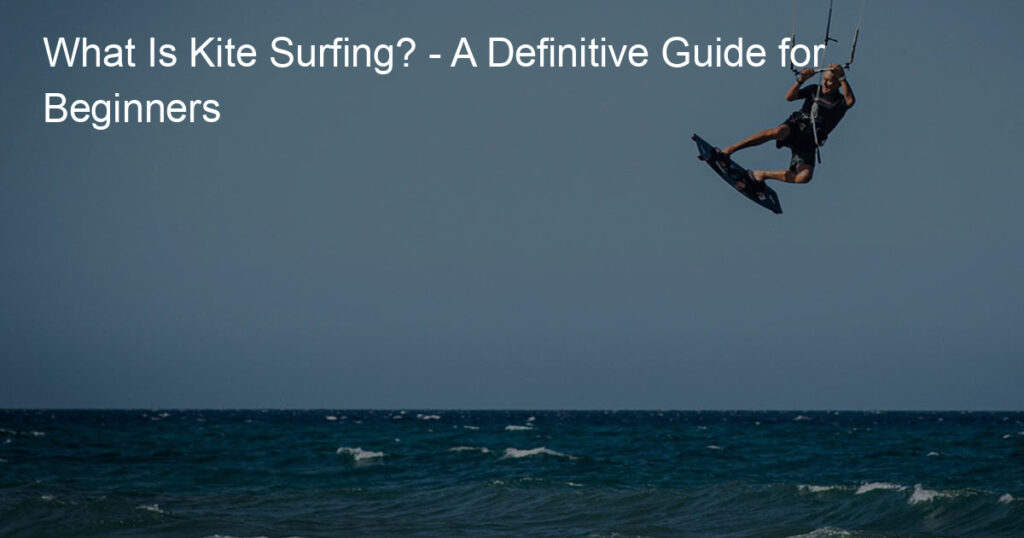Kite surfing, also known as kiteboarding, is a thrilling water sport that combines elements of wakeboarding, surfing, windsurfing, snowboarding, paragliding, and skateboarding.
The sport harnesses the power of the wind through a large, parachute-like kite to propel a rider across the water on a small surfboard or kiteboard.
With a unique mix of aerial and water-based techniques, it has quickly gained popularity among adventure enthusiasts and extreme sports lovers alike.
To get started with kite surfing, it’s crucial to understand what is kite surfing and the essential equipment and principles of the sport.
Proper training and guidance from experienced professionals can help you safely build essential skills, such as controlling the kite, finding the right body posture and balance, and using wind power effectively.
By mastering the art of kite surfing, you’ll be able to experience the excitement of soaring through the air and riding the waves with unparalleled freedom.
Key Takeaways
- Kite surfing is a thrilling water sport combining elements of various action sports and uses a kite to propel the rider on water.
- Learning and understanding the equipment and principles of kite surfing is vital for a successful experience.
- Proper training from experienced professionals can help you build essential kite surfing skills and increase safety.
The Basics of Kite Surfing

What Is Kite Surfing?
Kite surfing, also known as kiteboarding, is a thrilling water sport where you harness the power of the wind with a large kite to propel yourself across the water on a specialized board. As you glide across the surface, you’ll use your body weight to steer and control the kite.
This adrenaline-pumping activity requires a combination of skills from surfing, wakeboarding, and windsurfing, making it a unique and challenging pursuit.
History of Kite Surfing
The origins of kite surfing can be traced back to the late 1970s and early 1980s when various inventors and enthusiasts experimented with using kites to pull themselves across the water.
However, it wasn’t until 1998 that the sport gained significant traction with the formation of the International Kiteboarding Association (IKA).
Since then, kite surfing has grown exponentially in popularity and has even been recognized as a competitive sport with international championships and events.
As you embark on your kite surfing journey, remember to prioritize safety by learning from qualified instructors and using appropriate gear.
With practice, patience, and determination, you’ll soon find yourself soaring across the waves and enjoying the endless possibilities that kite surfing offers.
Understanding the Equipment
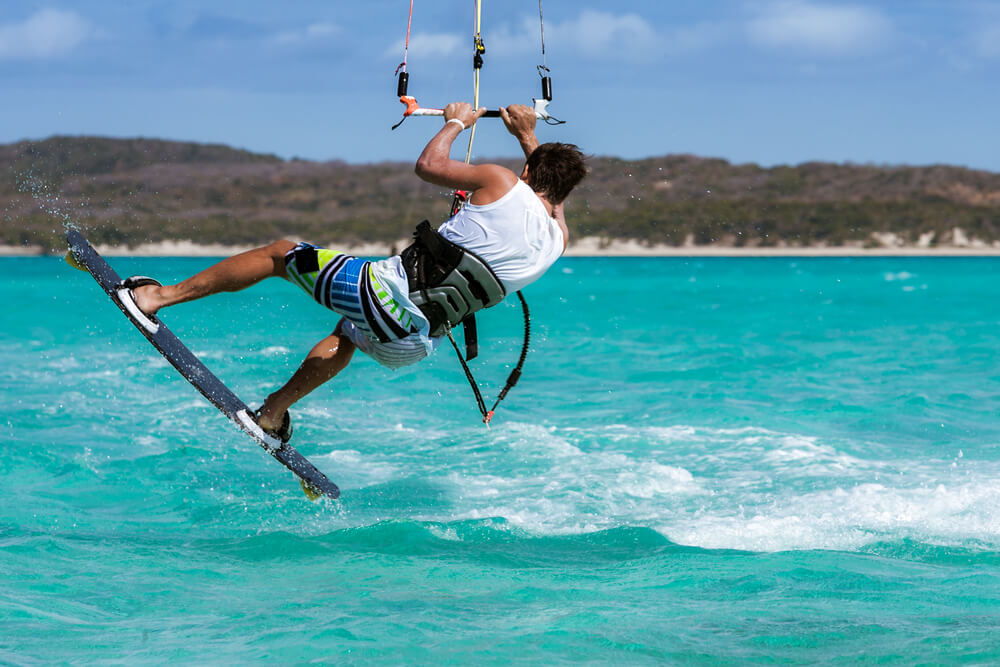
Kite surfing is an exciting water sport that requires specific equipment to ensure a fun and safe experience.
In this section, we’ll discuss the essential gear you need, including kite selection, board types, and other necessary equipment.
Kite Selection
Selecting the right kite is crucial for a successful kite surfing session. The kite provides the power needed to propel you through the water.
Typically, kites are constructed using lightweight fabric and supported by inflatable struts filled with air, allowing them to float and maintain their shape.
When choosing a kite, consider factors such as your skill level, wind conditions, and your body weight.
Beginners usually start with a smaller kite to manage the power easily, while more experienced kite surfers may opt for larger kites, allowing them to harness more wind for increased speed.
Board Types
There are several types of boards available in the market, each suited for different skill levels and kite surfing styles:
- Twin Tips: These are the most common boards used by beginners due to their versatility and ease of use. They have a symmetrical shape, allowing riders to ride in both directions without changing their feet’ positions.
- Directional Boards: Directional boards are designed for more advanced riders looking for a surf-style experience. They typically have a larger surface area and are better suited for riding waves and performing aerial tricks.
- Hydrofoil Boards: These boards are equipped with a hydrofoil underneath, which lifts the rider above the water surface, reducing drag and providing a smoother ride. Hydrofoil boards are ideal for experienced riders looking for a unique and efficient kitesurfing experience.
Other Essential Gear
In addition to selecting the right kite and board, there are a few other pieces of equipment necessary for a safe and enjoyable kite surfing experience:
- Harness: A harness is used to attach the rider to the kite, distributing the kite’s pull across the rider’s body. There are two main types of harnesses: waist and seat. Waist harnesses provide more freedom of movement and are preferred by most kite surfers, while seat harnesses offer more lower back support and are suitable for beginners.
- Control Bar: The control bar is used to steer the kite and adjust its power. It is connected to the kite through lines made of Dyneema, Spectra or Kevlar, which have minimal stretch and float in water ^2^.
- Safety Equipment: A life jacket or impact vest, helmet, and wetsuit are essential safety gear to protect yourself while kite surfing.
Understanding the equipment is crucial for getting started in kite surfing.
Take your time to choose gear that suits your skill level, preferences, and local conditions to ensure a safe and enjoyable experience on the water.
Principles of Kite Surfing
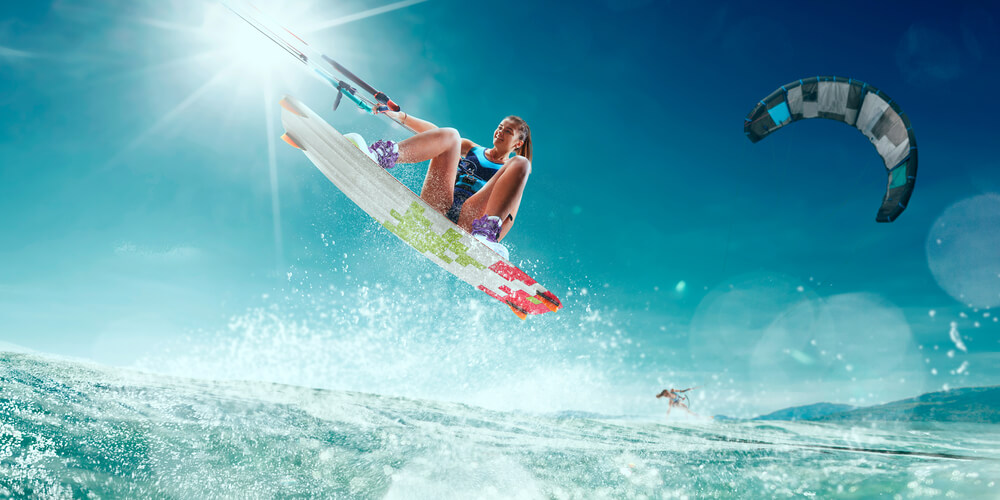
The Science Behind Kite Surfing
Kite surfing, also known as kiteboarding, is a water sport that harnesses the power of the wind to propel you across the water on a kiteboard (similar to a wakeboard) with the help of a large parachute-type kite.
The kite acts as the connection between you and the wind, allowing you to channel the wind’s energy into forward motion.
By steering the kite through specific patterns, you can control the speed and direction of your movement on the water.
Key Techniques
To become a proficient kite surfer, you’ll need to learn several key techniques:
- Kite control: Learning how to maneuver your kite in the air is crucial for kite surfing. Start by practicing kite flying on land before progressing to the water. Get comfortable with steering the kite, generating power, and stopping when necessary.
- Body dragging: Before you’re ready to ride a kiteboard, you’ll need to master body dragging – getting pulled through the water by the kite without the board. This skill is essential for water starts and recovering your board if you lose it while riding.
- Water start: Once you’ve developed your kite control and body dragging skills, you’ll progress to water starts. This involves positioning the kite and board correctly, allowing the kite’s pull to lift you out of the water and onto the board.
- Riding upwind: One of the most important skills in kite surfing is riding upwind. To do this, you’ll need to angle your board correctly and maintain efficient kite control. Riding upwind allows you to return to your starting point and avoid getting swept downwind.
By mastering these key techniques, you will be well on your way to becoming a confident kite surfer.
Keep in mind that progression in kite surfing takes time and practice, so don’t be discouraged if you don’t grasp all the techniques immediately.
Getting Started
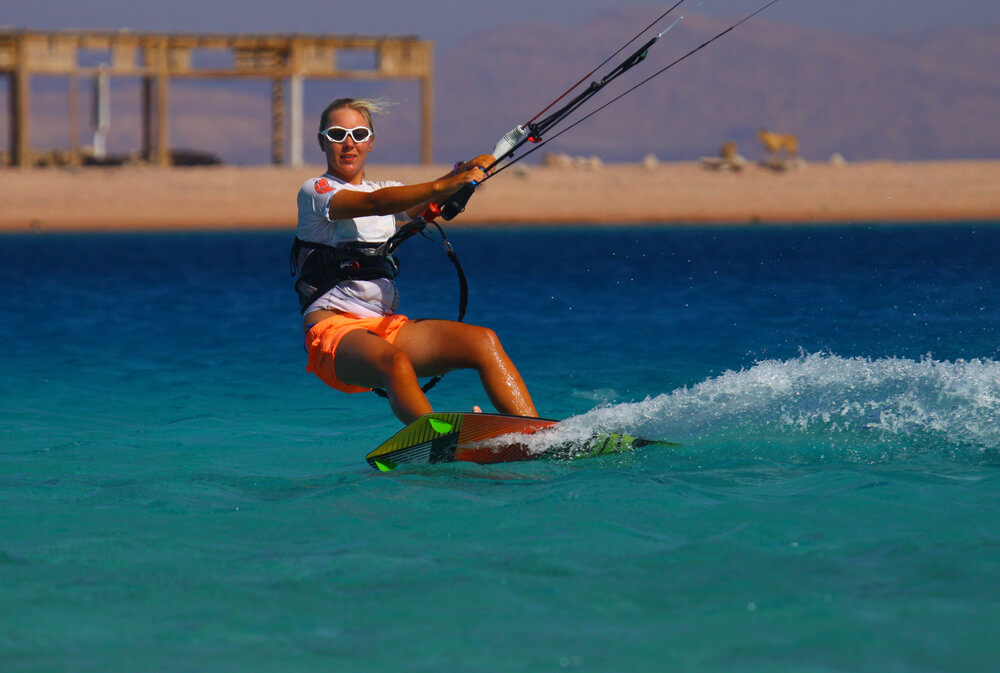
Learning to Kite Surf
Kite surfing is a wind-powered watersport that uses a kite and a board to propel you across the water. Even though it is called kitesurfing, it doesn’t necessarily involve wave surfing; it can be done on flat water as well source.
To start with this exciting sport, you need to build a solid foundation. It’s essential to develop strong control over the kite while maintaining balance on the board.
If you’re already into sports like surfing or running, then you probably have the physical fitness required for kite surfing source.
Yet, having a fit body alone isn’t enough; you must also possess essential skills like swimming, wind knowledge, and kite control.
Choosing a Kite Surfing School
Opting for professional lessons is recommended to ensure you learn kite surfing correctly and safely. Instructors from kite surfing schools play a vital role in helping beginners master the essential techniques while avoiding risks.
Start by researching and comparing various schools and their instructors. Check for certifications and experience to find a suitable match that aligns with your expectations.
Some factors to consider when selecting a kite surfing school include:
- Location: Select a location that provides the right wind and water conditions suitable for learning.
- Reputation: Read reviews and testimonials from past students to gauge the quality of instruction.
- Equipment: The school should provide all necessary equipment during lessons.
- Certifications: Confirm that the instructors are certified by recognized organizations like International Kiteboarding Organization.
Key Safety Measures
Safety should always be your top priority while learning to kite surf.
Below are some crucial safety measures you need to keep in mind:
- Weather awareness: Be aware of the local weather forecast and wind conditions before heading out to kite surf. Avoid going out in stormy conditions or extreme winds that are beyond your skill level.
- Check your gear: Inspect your kite, lines, harness, and board for any damage prior to each session.
- Use safety gear: Wear a helmet, impact vest, and appropriate wetsuit or rash guard for protection.
- Know your limits: Don’t push yourself beyond your skill level or attempt tricks without proper guidance.
By following these safety measures and choosing the right kite surfing school, you will set a strong foundation for a successful and enjoyable kite surfing journey.
Kite Surfing Challenges and Opportunities
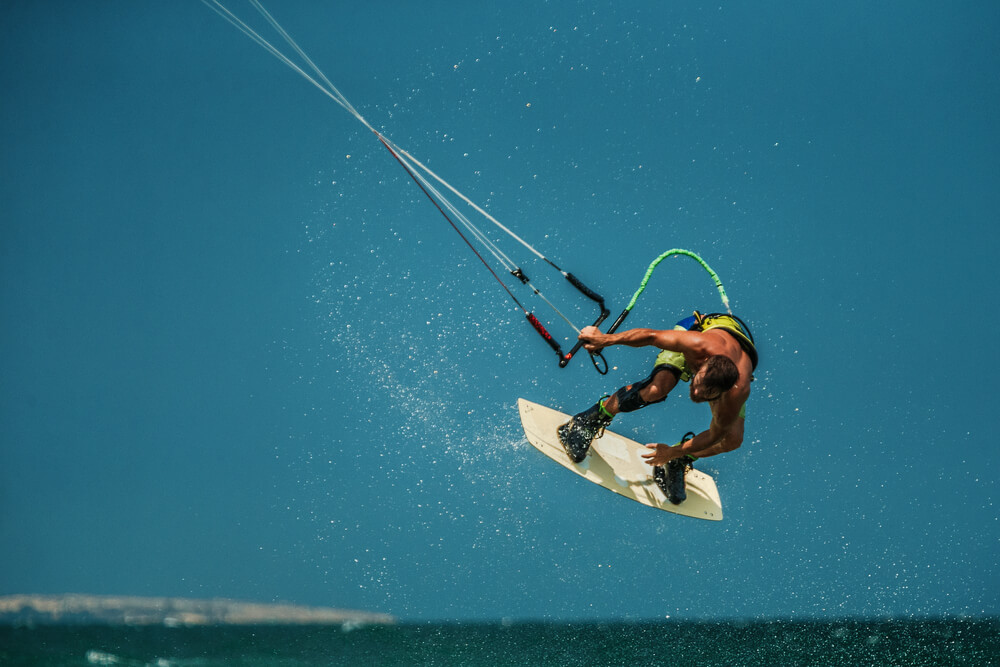
Common Pitfalls
When learning kite surfing, it’s important to be aware of common pitfalls. One major challenge for beginners is understanding wind direction and kite control.
You need to keep your kite in the correct position depending on the wind direction. Misjudging this can result in a loss of control, potentially leading to accidents or injuries.
Another common issue is selecting the right equipment. As a beginner, you should choose a smaller kite, as it provides better control and minimizes risks.
Boards with more surface area will also make it easier for you to learn and maintain balance.
Finally, don’t underestimate the importance of proper training. Invest in quality lessons from a certified instructor to gain essential skills and knowledge needed for safe and enjoyable kite surfing.
Taking Part in Competitions
Once you’ve honed your skills, you might be interested in participating in competitive events. Kite surfing competitions can be an exciting way to test your abilities and meet fellow enthusiasts.
Before you enter a competition, ensure you’re familiar with the different disciplines. Some events focus on freestyle, big air, or wave riding, while others may feature slalom or speed races.
Knowing what to expect will help you prepare and train effectively for each event type.
When competing, always prioritize safety. Follow the rules, listen to event organizers, and respect your fellow competitors.
Participating in competitions is a great opportunity to learn from others, push your limits, and showcase your abilities in the world of kite surfing.
Global Kite Surfing Scene

Popular Kite Surfing Destinations
Kite surfing, also known as kiteboarding, is a thrilling sport that has gained immense popularity worldwide. Some of the top kite surfing destinations include:
- Cabarete: This coastal town in the Dominican Republic is well-known for its excellent wind conditions and pristine beaches, making it a perfect spot for kite surfers of all levels.
- La Ventana: Situated on the eastern coast of Baja, California, Mexico, it offers consistent winds and uncrowded spots, providing an unforgettable kite surfing experience.
- Cape Town: This South African city boasts strong winds and stunning scenery, attracting adventurous kite surfers who want to push their limits.
- Le Morne: Located on the southwest coast of Mauritius, this picturesque area offers flat water lagoons and waves for those seeking an epic ride.
You can find more amazing kite surfing destinations in this roundup of the 10 best spots worldwide.
Notable Kite Surfers
The global kite surfing scene has been influenced and shaped by several outstanding athletes.
Here are some notable names in the sport:
- Aaron Hadlow: A five-time world champion from the UK, Hadlow has been a significant figure in the sport since he started competing at a young age.
- Susanne Mai: A top female kite surfer from Germany, she has held several speed records and motivated many other women to take up the sport.
- Robby Naish: Although better known for windsurfing, Naish, an American pioneer of wind-powered sports, has also made substantial contributions to the kite surfing industry.
Keep exploring the world of kite surfing, witnessing its compelling history and evolution, and maybe one day, you’ll find yourself among the ranks of these iconic athletes.
Conclusion
Kitesurfing is an exciting and thrilling water sport that can be enjoyed by people of all ages and abilities. With the right instruction, practice, and safety precautions, you can learn to kitesurf and enjoy this rewarding activity.
It’s essential to understand that kitesurfing combines aspects of multiple sports, such as paragliding, surfing, windsurfing, skateboarding, snowboarding, and wakeboarding.
As a result, you’ll experience a unique blend of adrenaline-packed, wind-powered action with the freedom to explore various water, land, or snow surfaces.
To begin your kitesurfing journey, you’ll need the proper equipment, which includes a power kite, kiteboard, kitesurfing harness, and appropriate safety gear.
Keep in mind the importance of choosing the right kite size for your weight and wind conditions to ensure a safe and enjoyable experience on the water.
Safety should always be your top priority when kitesurfing.
Before heading out, invest some time in learning about the necessary precautions and techniques through certified kiteboarding schools, instructors, or online tutorials.
Kitesurfing is a sport that demands both dedication and awareness.
By committing to learning the skills and maintaining your safety, you can enjoy the thrilling experience of harnessing the wind’s power and gliding across water, land, or snow.
So gear up, practice responsibly, and let your kitesurfing adventure begin!
Frequently Asked Questions
How much does kite surfing cost?
Kite surfing can vary in cost depending on factors such as equipment, lessons, and location. You will need a kite, a board, a harness, and other safety gear.
The initial investment for equipment can range from $1000 to $3000. In addition, lessons usually cost around $300 to $600.
Regardless, once you have your own gear and basic skills, kite surfing expenses decrease significantly.
Is it difficult to learn kite surfing?
Learning kite surfing can be challenging, but with proper training and practice, you can definitely master this thrilling sport.
It is essential to take lessons from a certified instructor and practice in suitable conditions.
As you progress, you’ll find yourself improving and enjoying the adrenaline-pumping experience of kite surfing.
What’s the difference between kite surfing and windsurfing?
While both sports involve riding on the water while powered by the wind, kite surfing, and windsurfing utilize different equipment and techniques.
In kite surfing, you’ll be propelled by a kite that you control with a bar, standing on a small board. In windsurfing, you stand on a larger board with an attached sail, using your body to control the sail’s position.
Both sports have unique characteristics and learning curves, but the fun and challenges are worth the effort.
What are the benefits of kite surfing?
Kite surfing is not only an exciting sport but also offers numerous physical and mental benefits. It helps improve balance, coordination, and upper body strength as you maneuver the kite and board on the water.
Additionally, being outdoors and engaging in an intense activity helps reduce stress, improve focus, and boost overall well-being.
How risky is kite surfing?
As with any extreme sport, there are risks associated with kite surfing, such as potential injuries due to accidents or collisions.
Nevertheless, most of these risks can be minimized by learning from a qualified instructor, using appropriate safety gear, checking weather conditions, and practicing in designated areas.
With proper precautions, kite surfing can be an exhilarating and safe sport.
Can you kiteboard on land?
Yes, you can actually practice and enjoy kiteboarding on land using a suitable board, such as a mountain board or a buggy.
Land kiteboarding provides a great way to enhance your skills and enjoy the sport when the water conditions are not favorable.
Remember to follow safety guidelines and practice in open areas away from obstacles for a safe and fun experience.

